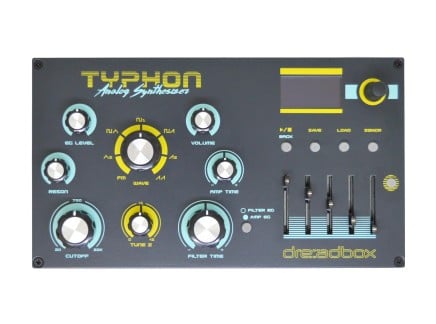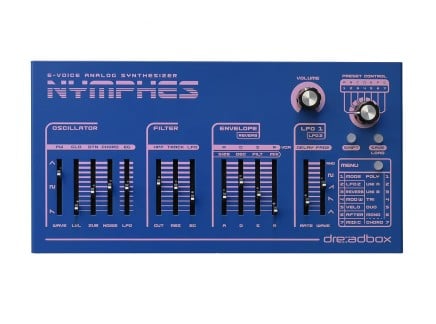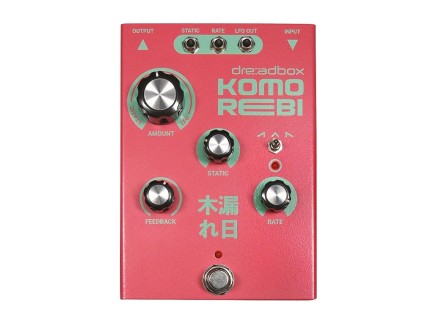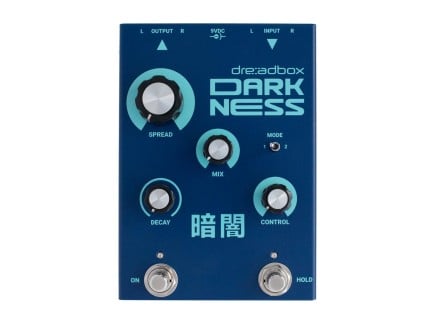Dreadbox have long been known for their unique designs and often aggressive sound—from their Murmux and original modular systems to the ever-popular Erebus and Nyx, they have a workflow, sound, and appearance all their own. And the same is certainly true of their newest offering, the Typhon, which follows along with the retro-'80s design from the Hypnosis effect unit and brings the classic edgy Dreadbox sound to an even more approachable price point.
Typhon is a surprisingly deep instrument given its size and price point. It features some clever macro controls, a spectacular filter, an integrated sequencer, digital effects by Sinevibes, and a surprisingly powerful internal modulation system. We can't hope to cover every single feature, but let's take a look at some of the interesting aspects of this synth's design, and figure out how it might fit into your own workflow.
Analog Sound in the Typhon
First things first: Typhon is an analog synth with digital control and digital effects. This keeps the audio signal path warm and clean, and still allows for the flexibility of digital reverbs and audio processes, as well as a surprisingly open-ended modulation system. Let's take a look at the analog side of Typhon first.
Typhon features two oscillators and a 24dB/oct resonant lowpass filter. Each oscillator has the option of multiple wave shapes, and you can achieve a large number of classic synthesis techniques like FM, PWM, and detuning tricks with just two knobs. That's right—there's no waveform selection switches, modulation depth controls, or anything of the sort here. Instead, Dreadbox have lumped many options for oscillator control beneath a single large, central knob, which is simply labeled "Wave."
The Wave parameter allows you to select between a wide range of sonic behaviors, as indicated by the graphics surrounding the knob. By sweeping the range of this knob, you simultaneously change the level and shape of each of the two oscillators, with several hardwired "milestones" in-between. Going counterclockwise, you can have two simultaneous sawtooth waves, a single saw (from the second oscillator), a square and a saw, a square (from the first oscillator), a square and a triangle, a single triangle (from the second oscillator), and two-oscillator FM, in which the second oscillator is the modulator and the first oscillator's square is the carrier. What's more, this parameter isn't operated by a switch—you can continuously fade from one setting to the next, discovering a world of sounds in between. What's more, on the left side of the knob, you'll notice oscillator one's square gradually alters in width, allowing for PWM effects. This is an intuitive and quite smart way to control tons of parameters with a single knob...which, in combination with modulation, can result in effects not possible on many synthesizers altogether.
Oscillator 2 has a tuning offset knob below the main Wave knob, allowing you to dial in precise tuning ratios between the two oscillators. This knob allows you to set oscillator 2 to anywhere up to two octaves above oscillator 1, and is quantized in semitones—making it simple to dial in stacked fifths or other clean intervals. Interestingly, there is no quantization immediately around the unison, +1 octave, or +2 octave settings, making it easy to dial in near unisons...a classic way of quickly creating a sense of movement within a sound.
Of course, with Dreadbox-style FM, saws, and squares, you generate a ton of bright, edgy harmonic content. Happily, the signal next passes into a warm and deep-sounding 24dB/oct lowpass filter, making it easy to take the edgy raw sound of the oscillators and turn them into something surprisingly huge and smooth. The filter can self-oscillate, and what's more, you can actually use the oscillators to frequency modulate the filter. At high FM levels, this creates an incredible ripping/tearing sound, and for me, becomes part of this instrument's signature sound. The combination of intense sound sources with an intense analog filter, for me, makes it clear that this synth is great for huge, gnarly bass lines—so if you're looking for an affordable instrument to fill up some low end in your mix, Typhon is a great contender.
Digital Effects by Sinevibes
After the filter and VCA, the sound passes into a digital effect section with three effect slots, each dedicated to a specific type of effect. FX1 slot is for distortion-style effects, and includes classic S-Curve saturation, a wave folder, a sample rate/bit depth reducer (aka bit crusher), and novel modes called tri-clip and shred. These effects take the softened post-filter sound and bring back some edginess. And they offer far more color than the typical distortion: you can use the bit crusher to create everything from garbled digital nonsense to stunning vocal effects, and can use the wave folder to add some gnarly Buchla-style twang to your sound (especially nice when used in combination with the filter FM, by the way).
The next effect slot is dedicated to "Enhancers"—time-based effects like chorus, ensemble, and flanger. These are very clean effects, and in combination with the varied sounds from the oscillators and filter can create everything from murky, swarming stereo movement to hard sync-like flanger sweeps. The final effect slot is dedicated to "Reflections," or longer term spatial effects. These include a stereo delay with independent time settings per channel, a ping pong delay, and a wonderfully deep and rich reverb. The reverb also contains a feedback control—an especially nice touch for creating long, ringing resonances and metallic droning textures. In fact, this reverb is so deep and lush that it's easy to use it to create the illusion of polyphony, smearing monophonic lines into chords that ring out and decay.
Modulation in the Typhon
Of course, an analog synth without modulation is not a synth worth having. Despite its simple appearance, perhaps the Typhon's strongest feature is the extensiveness of its modulation options. Let's first look at some of the simpler sources, and then talk about its pseudo-mod matrix.
The most obvious mod sources you're likely to use in every sound—the amp and filter envelopes. These are standard ADSR envelopes, but you'll notice that the panel lacks any typical envelope controls (with the exception of a filter envelope depth control). Instead, the panel EG controls only relate to overall time: Filter Time, and Amp Time, respectively. ADSR values are actually entered via the multi-purpose sliders on the right side of the unit, but the dedicated Filter/Amp time controls can be used to expand or shorten the overall duration of each envelope independently. This makes for an interesting set of performance controls, in which you can go from a vastly different range of articulation by turning only one or two knobs.

Beyond these basic controls, though, lies a fairly complex modulation system. Each Typhon patch has three internal modulation slots. Now, you might think that three modulation slots couldn't possibly be enough...but this isn't your typical modulation matrix. Rather that each slot being comprised of a single source and destination, each slot instead has a single source which can be routed in parallel to every destination: part of the modulation slot includes a bipolar "send" amount for every viable modulation destination in the instrument. You can modulate each oscillator's pitch independently or in tandem, you can modulate the Wave parameter (great for crossfading and PWM effects), filter cutoff, filter resonance, FX mix levels, and more. Each modulation slot's source can be any modulator: an auxiliary ADSR envelope, an LFO (with saw, square, pulse, trapezoid, and "chaos saw" waveforms as well as fade in/fade out times), a random S&H with probability and slew controls, and a modulation sequencer with up to 32 steps, which may or may not be synced to the master tempo. Typhon also features a not dissimilar note sequencer—capable of anywhere up to 32 steps, completely with probability controls and an option for MIDI note entry.
Beyond this pseudo modulation matrix, there are similar direct modulation routing menus for physical control sources (pitch and mod wheel, velocity, key tracking, CCs, etc). Diving this deep into the Typhon's menus is admittedly a bit tedious, but can lead to some highly expressive results.
Altogether, Typhon is an amazing value—a powerful analog monosynth with a huge, edgy sound for under $400. Some of the deeper aspects of programming are a bit tedious for my taste, and I wouldn't necessarily recommend this as someone's first synthesizer, as its approach is a bit esoteric. However, if you're looking for a powerful, heavy-hitting addition to your studio or live setup, the price and feature set is hard to beat...just expect to take some time when designing your own patches.
All in all, Typhon brings a lot of unique features together into a surprisingly small and affordable package with a huge number of very usable presets. If you want something that can go from lush and washy to grinding distortion and modulated textures, this new offering from Dreadbox might just fit into your setup.











